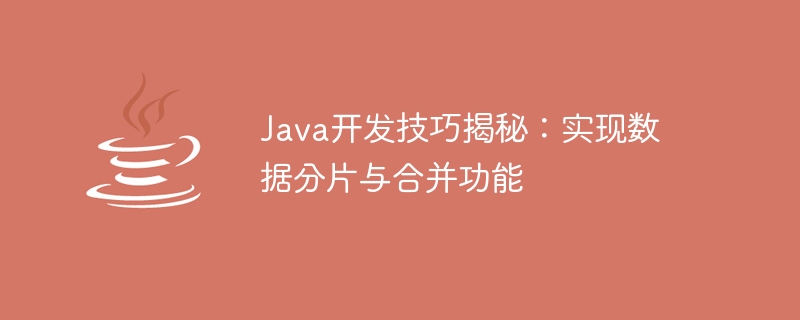
Java development skills revealed: Implementing data sharding and merging functions
As the amount of data continues to grow, for developers, how to process big data efficiently has become an important topic. In Java development, when faced with massive data, it is often necessary to segment the data to improve processing efficiency. This article will reveal how to use Java for efficient development of data sharding and merging functions.
Data sharding refers to dividing a large data collection into several small data blocks, and each small data block is called a piece. Each piece of data can be processed in parallel to improve processing efficiency. In Java development, multi-threading or distributed computing frameworks are often used to implement data sharding.
When dividing shards, you need to consider the characteristics of the data and the way it is processed. The following are several common partitioning strategies:
a. Uniform partitioning: Divide the data set into several small data blocks evenly. This partitioning strategy is suitable for scenarios where the size of the data collection is relatively uniform.
b. Hash partitioning: Hash calculation is performed based on a certain attribute of the data, and data with the same hash value is divided into the same shard. This division strategy is suitable for scenarios where certain attribute values are similar.
c. Range division: Divide according to the range of a certain attribute of the data, and divide the data within the range into the same shard. This division strategy is suitable for scenarios where the range of an attribute value is continuous.
In Java development, you can use multi-threading or distributed computing framework to implement data sharding. The following is a sample code that uses multi-threading to implement data sharding:
class DataShardingTask implements Runnable {
private List<Data> dataList;
public DataShardingTask(List<Data> dataList) {
this.dataList = dataList;
}
@Override
public void run() {
// 对数据进行处理
for (Data data : dataList) {
// 处理数据的逻辑
}
}
}
public class DataSharding {
public static void main(String[] args) {
List<Data> dataList = new ArrayList<>();
// 初始化数据集合
int threadCount = 4; // 线程数量
int dataSize = dataList.size(); // 数据集合大小
int shardSize = dataSize / threadCount; // 每个线程处理的数据量
ExecutorService executorService = Executors.newFixedThreadPool(threadCount);
for (int i = 0; i < threadCount; i++) {
int start = i * shardSize;
int end = (i == threadCount - 1) ? dataSize : (i + 1) * shardSize;
List<Data> shard = dataList.subList(start, end);
executorService.execute(new DataShardingTask(shard));
}
executorService.shutdown();
}
}In the above sample code, by dividing the data collection into several shards, and then using multi-threading to process each shard, to improve processing efficiency.
After the data fragmentation processing is completed, it is often necessary to merge the results of the fragmentation processing. The following is a sample code that uses Java Stream API to implement data merging:
class DataMergeTask implements Callable<Data> {
private List<Data> shard;
public DataMergeTask(List<Data> shard) {
this.shard = shard;
}
@Override
public Data call() {
// 合并数据的逻辑
Data mergedData = new Data();
for (Data data : shard) {
// 合并数据的逻辑
// mergedData = ...
}
return mergedData;
}
}
public class DataMerge {
public static void main(String[] args) throws InterruptedException, ExecutionException {
List<Data> dataList = new ArrayList<>();
// 初始化分片处理的结果数据集合
int shardCount = dataList.size(); // 分片数量
ExecutorService executorService = Executors.newFixedThreadPool(shardCount);
List<Future<Data>> futures = new ArrayList<>();
for (int i = 0; i < shardCount; i++) {
List<Data> shard = dataList.get(i);
futures.add(executorService.submit(new DataMergeTask(shard)));
}
executorService.shutdown();
List<Data> mergedDataList = new ArrayList<>();
for (Future<Data> future : futures) {
Data mergedData = future.get();
mergedDataList.add(mergedData);
}
// 处理合并后的数据集合
}
}In the above sample code, by using Java Stream API, the results of shard processing are merged to obtain the final processing result.
Summary:
In Java development, implementing data sharding and merging functions requires considering the sharding strategy and data processing methods. Using multi-threading or distributed computing frameworks can improve processing efficiency. Through the above techniques, developers can process large amounts of data more efficiently and improve system performance and response speed.
The above is the detailed content of Java development skills revealed: implementing data sharding and merging functions. For more information, please follow other related articles on the PHP Chinese website!